

Deep Core | Core | Colonies | Inner Rim | Expansion Region | Mid Rim | Outer Rim
Wild Space | Unknown Regions | Outer Galaxies | Other
ASTROGRAPHY
The locations of worlds, regions, and routes through the galaxy, as well as pre-canon history and development, have been established
over time by games, reference books, and other expanded universe material. Much of the galactic map has become so well established
as to be considered canon. The galactic plane has cardinal directions, with galactic north established by a radius which runs from
the center of the galaxy through the planet Coruscant, which was the center of civilization for nearly all interstellar history in the galaxy.

The known galaxy contains many millions of worlds. Millions more are in unknown regions, or lie within explored space but have never
been located or charted. Worlds shown on maps are among the most galactically significant, or those featured in canon films and shows,
as well as the expanded universe.

The number of starsystems and worlds increases the closer you get to the center of the galaxy, with the exception of the turbulent and often
inhospitable region at the center of the galactic core, where planetary systems are likely few or unusual, and hyperspace travel more difficult,
due to the strange physics caused by numerous radiative stars, gravitational annomolies, and supermassive black holes.
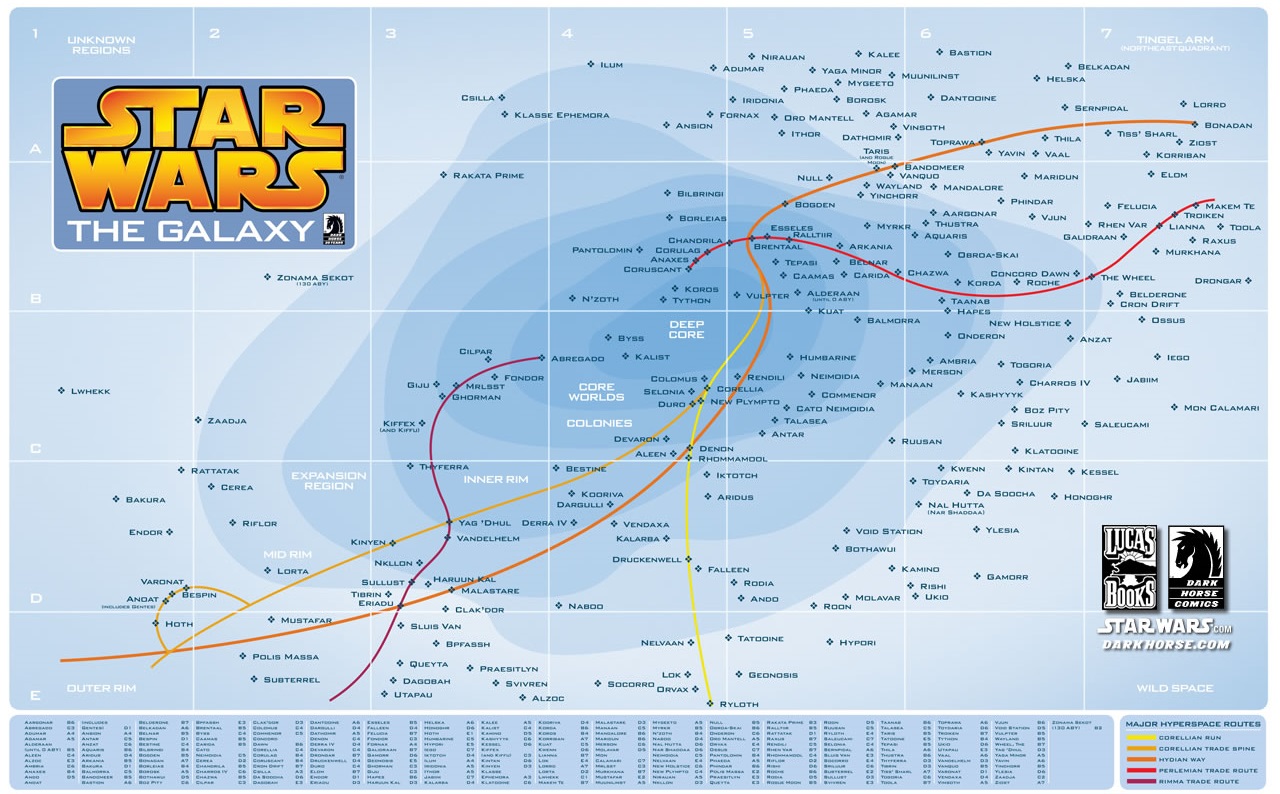
While many different maps exist, much of the astrography has become well-established. There are differences and even errors in some maps,
so it is best not to take any one map as completely authoritative, nevertheless most maps usually reference the same locations.


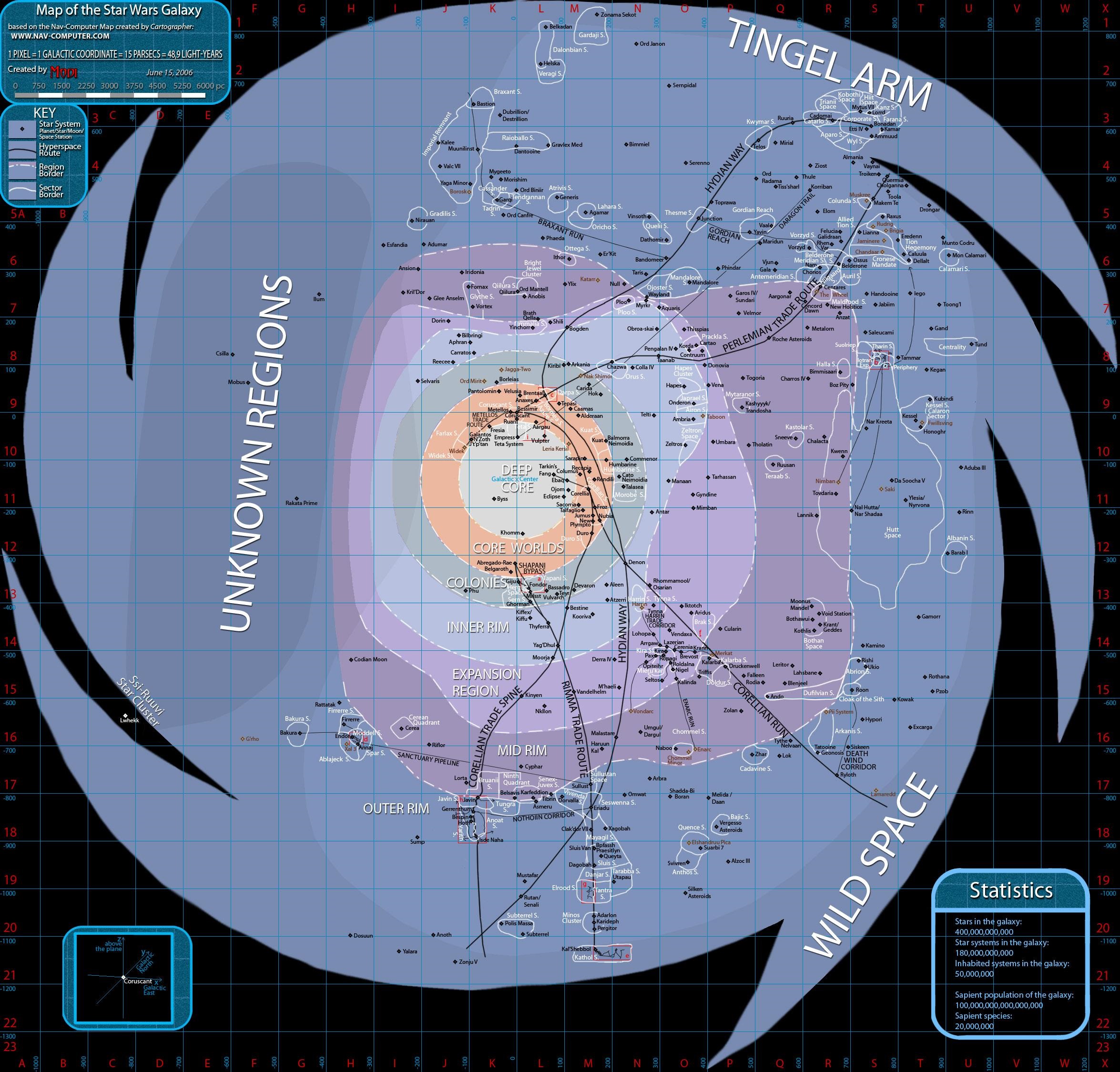

The most current disney-Lucasfilm map includes the locations of many planets seen in material over the last decade which had not previously
been mapped. It should not be taken as 100% correct, as there are at least three errors, however like most maps it is mostly accurate.
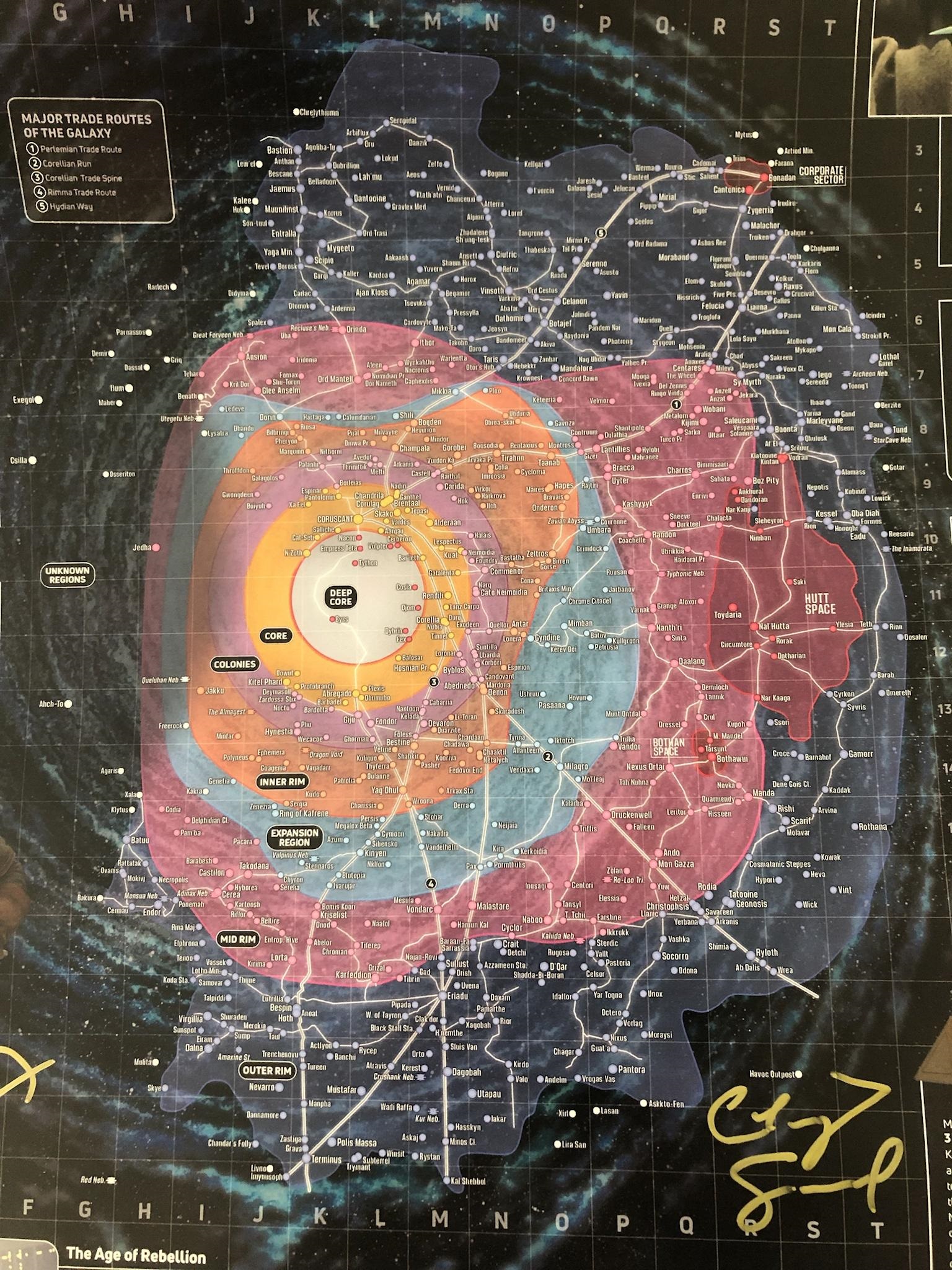
HYPERSPACE ROUTES
The major hyperspace routes are like the superhighways, or transgalactic railroads, of the galaxy.
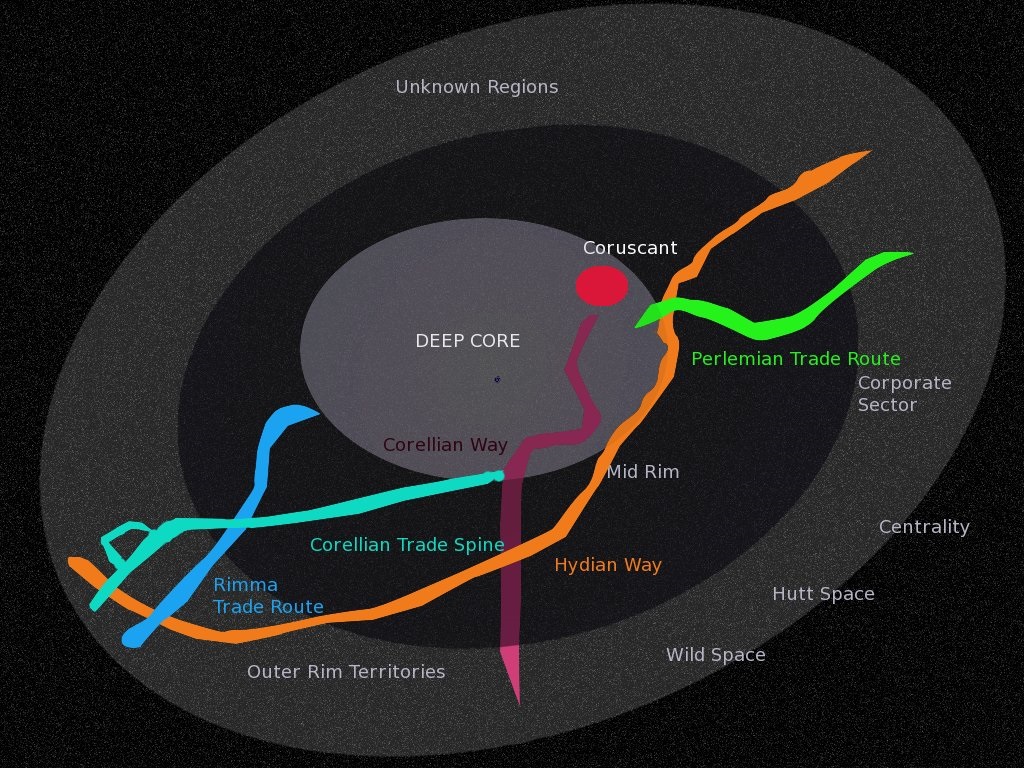
The settlement of regions of the galaxy was the cause and result of the exploration and development of the major established hyperspace lanes.

The major lanes feed to and from regional minor lanes, which themselves are fed by local lanes, paths, and runs, similar to a river and tributary
system. This process was very much like the development of a highway system from local roads that were expanded and augmented over time.

REGIONS OF THE GALAXY
The galaxy is divided into large regions based on distance from the galactic core. The names of these regions indicate their position in
the galactic disc, or their historical importance in Human settlement, colonization, and expansion in the galaxy. These massive circular
regions are subdivided into huge regions by the major hyperspace lanes which bisect them. These regions are subdivided into large
sectors, which themselves can contain smaller sectors. The size of sectors can range from small areas including many starsystems to
expansive areas including thousands of systems or more. Galactic regions usually contain tens or hundreds of thousands of starsystems.


There are also large areas of the known galaxy which span parts of multiple regions, or regional designations used colloquially or less
technically. The Core Worlds and regions like the Tion Cluster contain mostly long established planets, many of which have huge
populations. Areas like the New Territories, the Western Reaches, and the Trailing Sectors, are areas that were 'rural' frontiers that were
being actively explored, charted, settled, and developed in the millennia leading up to the films and shows, and sometimes still are.


Humans were not the only race to settle and colonize regions of the galaxy after the development of hyperspace technology, but were
certainly the most prolific. The Human homeworld of Coruscant is located in the core, and galactic development largely followed the pace
and directions of the Human expansion. The growing Human populations fueled the drive to locate and settle uninhabited worlds, as well as
colonizing worlds with sentient populations. Other spacefaring races with homeworlds located in and around the core of the galaxy were gradually
absorbed into the growing interstellar culture of the core, with non-Human races increasingly contributing to exploration and settlement.
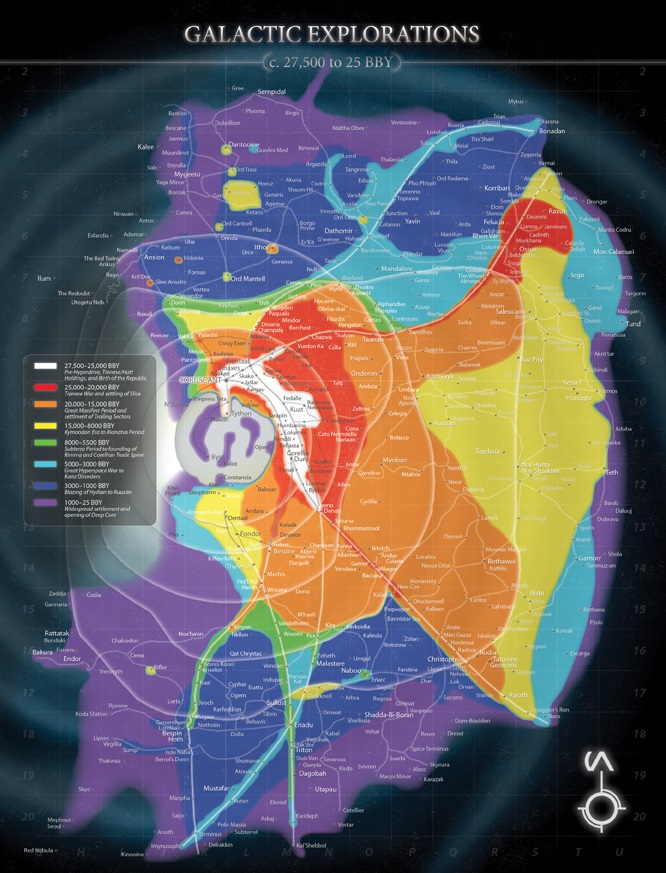
The history of the development of hyperspace technology and the exploration of the galaxy, in particular of the major hyperspace lanes,
is the primary factor in how well settled and populated a given region or starsystem has become by the era of the films and shows,
by which time the galaxy has a population in the trillions.
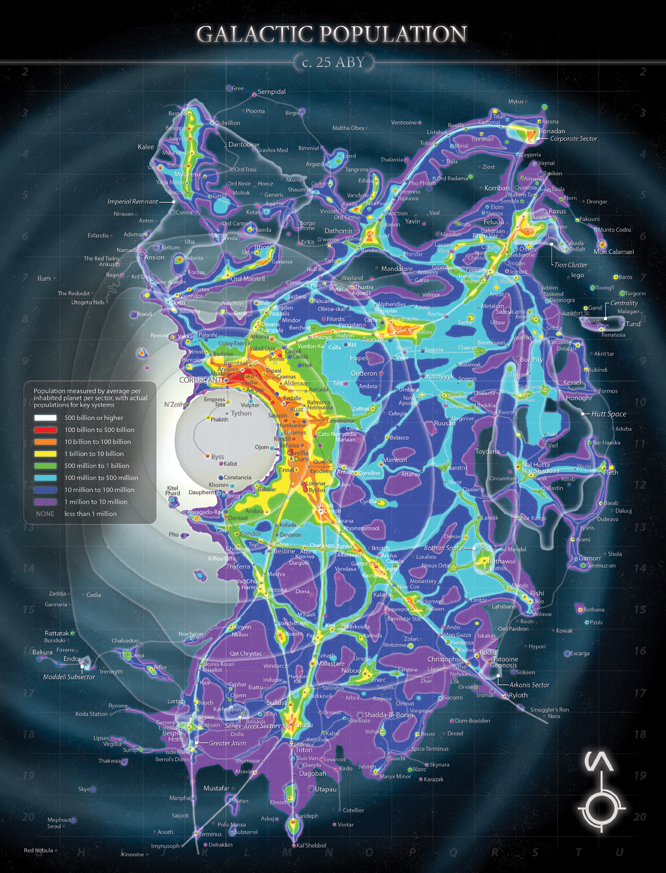
GALACTIC HISTORY
The interstellar ages of the galaxy began with the adoption and development of hyperspace technology by spacefaring civilizations.
Expansion in an era is limited by developments in the speed of hyperspace travel, the charting of safe hyperspace routes to reach new
worlds, the means to locate useful systems and worlds, the population of homeworlds and inhabited worlds, and interstellar politics.
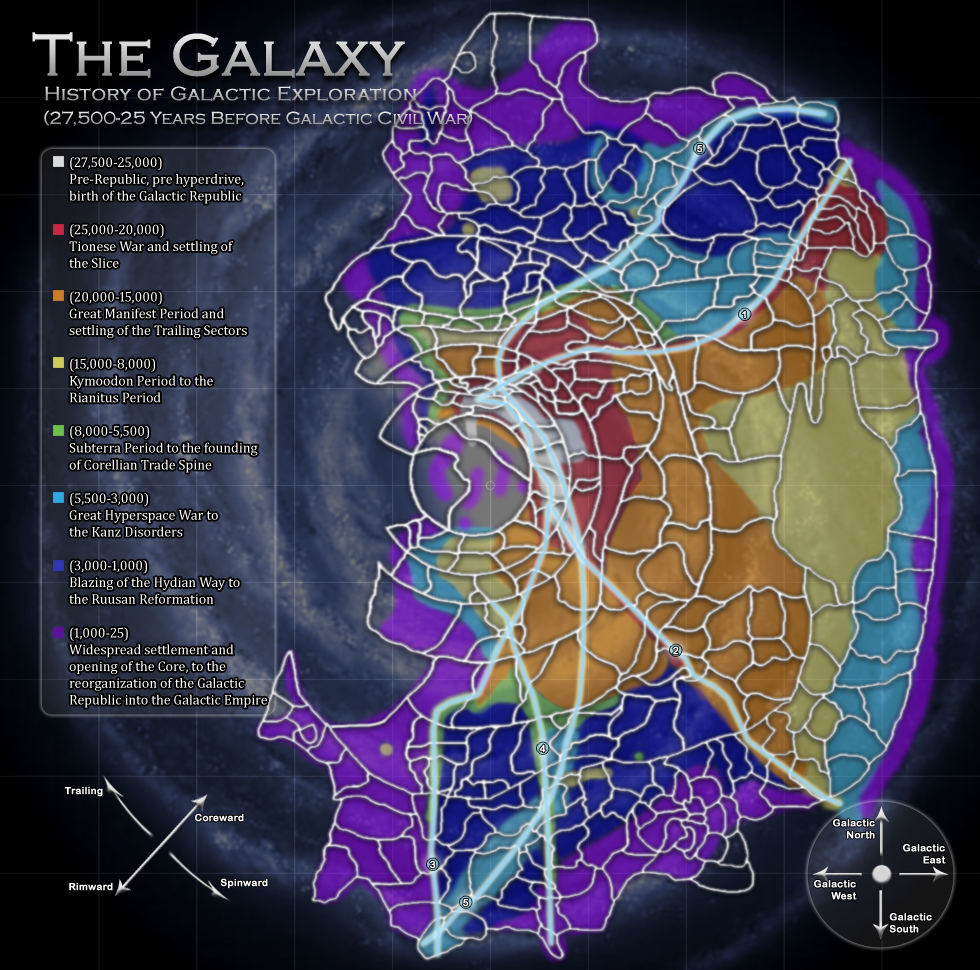
While Humans were by far the most prolific and expansive interstellar civilization, they were not the first or only species to develop
hyperspace technology. Non-Human worlds in the core and inner regions either developed hyperspace technology on their own, gained
access to it from interacting with other worlds, or were colonized by others giving their population access to galactic travel. Although
hyperspace travel was relatively slow in this era, contact with vital hyperspace capable civilizations in the galactic rim led to the development
of the first fully realized transgalactic hyperspace route, the Perlemian Trade Route, which established trade, settlement, and political
interaction between the Tion cluster, the Hutt domains, and the Human dominated core and inner regions.
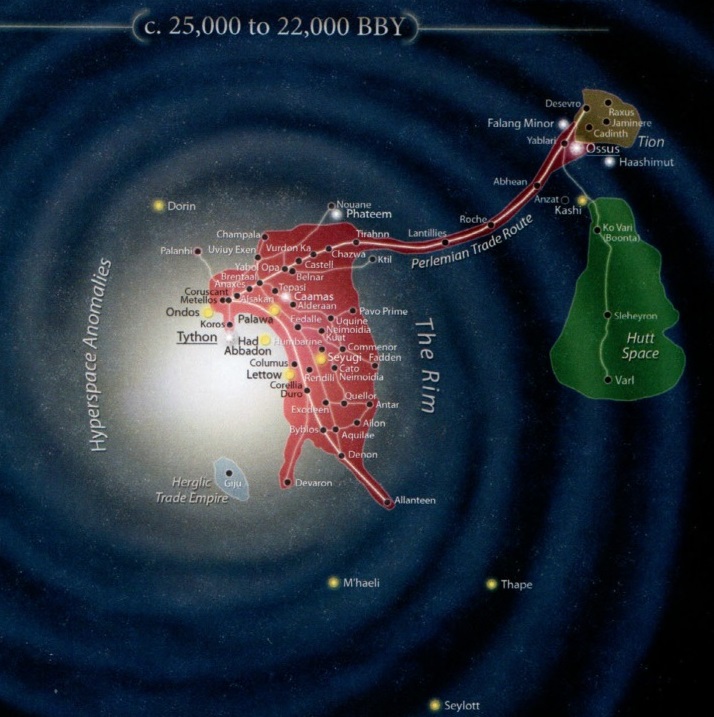
Advances in hyperspace travel and growing populations led to several eras of expansion in galactic civilization, and a corresponding
increase in the social, political, economic, and martial interaction between regions of the known galaxy. The interstellar middle ages saw
developments in hyperspace travel that made faster travel across sectors possible, and while travel was still much slower than in
the 'modern' era of the films, interconnectivity between settled regions brought developments in interstellar trade, culture, governments,
organizations, and technology. This era also saw the rise in prominence of interstellar religious societies, military orders, commercial
guilds, industrial concerns, piracy and crime, and larger scale imperial ambitions, both within and without the old Republic.
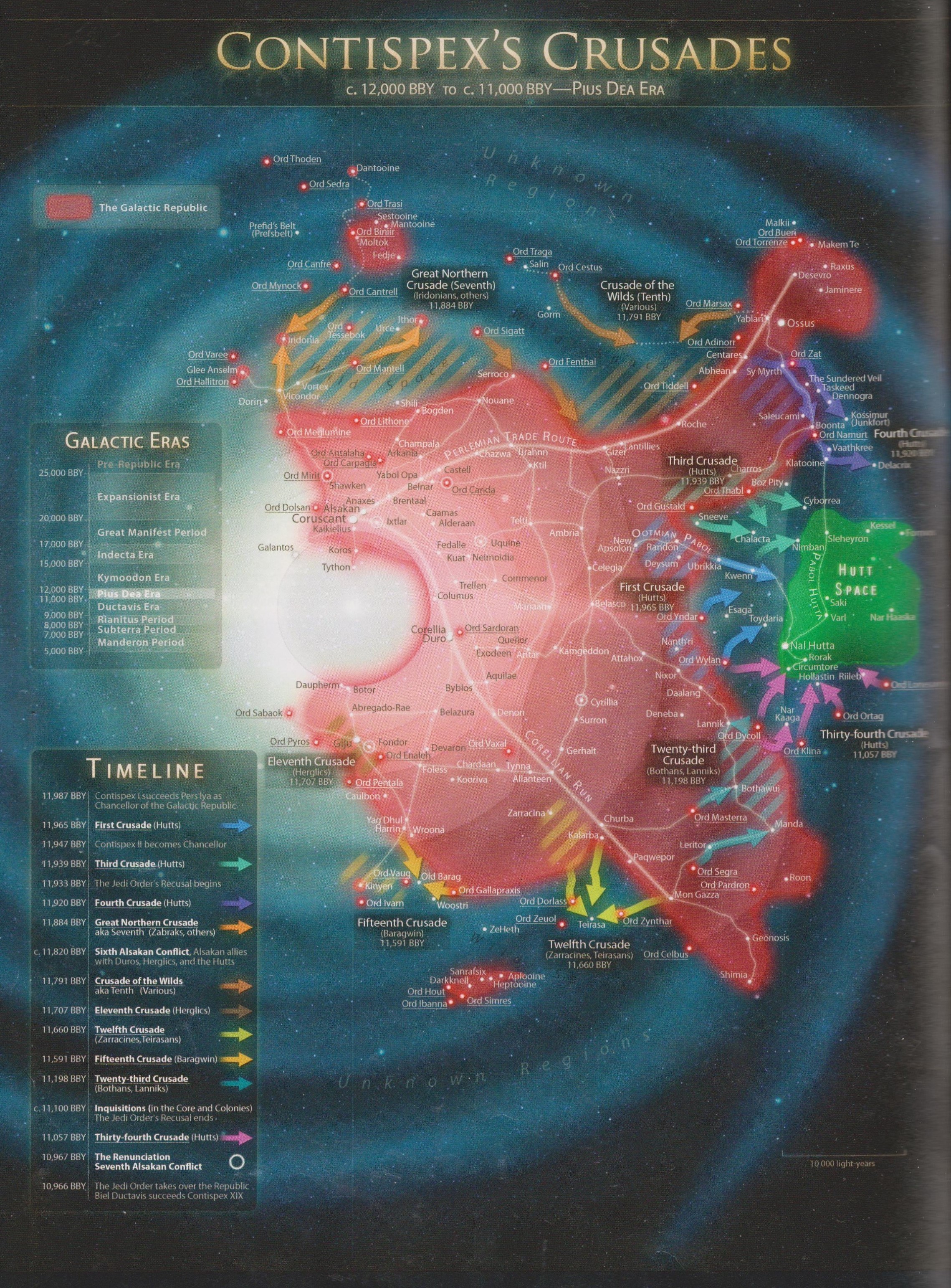
Over the course of millennia, the galaxy developed into its familiar alignment of five large regions. In the center, the coreward regions,
dominated by the old Republic and the Jedi Order. In the galactic 'east', the regions dominated by the Hutts and the various cultures that are
part of their cultural sphere, and the powerful and influential Tion Cluster. In the galactic 'south', the distant, poorly charted, and little
known outer rim. In the galactic 'west', the unknown regions, the area of the galaxy most distant and unconnected from the centers of
the major interstellar civilizations. In the galactic 'north', a region of opportunity. It included old local civilizations, regional powers,
worlds settled in earlier millennia that had developed and were on the rise, and many unsettled worlds, both charted and uncharted. This area
offered great opportunity for settlement, migration, and trade, as well as opportunities for power. Regional empires and states could more
easily arise and expand, and the region was influenced by the Republic, systems from the Tion Cluster, and even from the unknown regions.
This area eventually gave rise to a series of large empires, including some led by orders devoted to the dark side of the force, including the Sith.

Sith influence and control over the 'northern' regions led to the formation of successive Sith empires, which were regularly in conflict not only
with the old Republic and regional neighbors, but also within, as Sith lords, acolytes, and their forces often battled for power. This routinely
culminated in major conflicts, including the Great Hyperspace War, the Mandalorian-Jedi War, and the Great Sith War. The Sith Empire's control
over the known galaxy at times surpassed the old Republic, during a period in which the Sith conquered the Republic capital of Coruscant.
At the end of these millennia, the Republic and the Jedi succeeded in defeating the Sith Empire, but not the Sith Order itself.

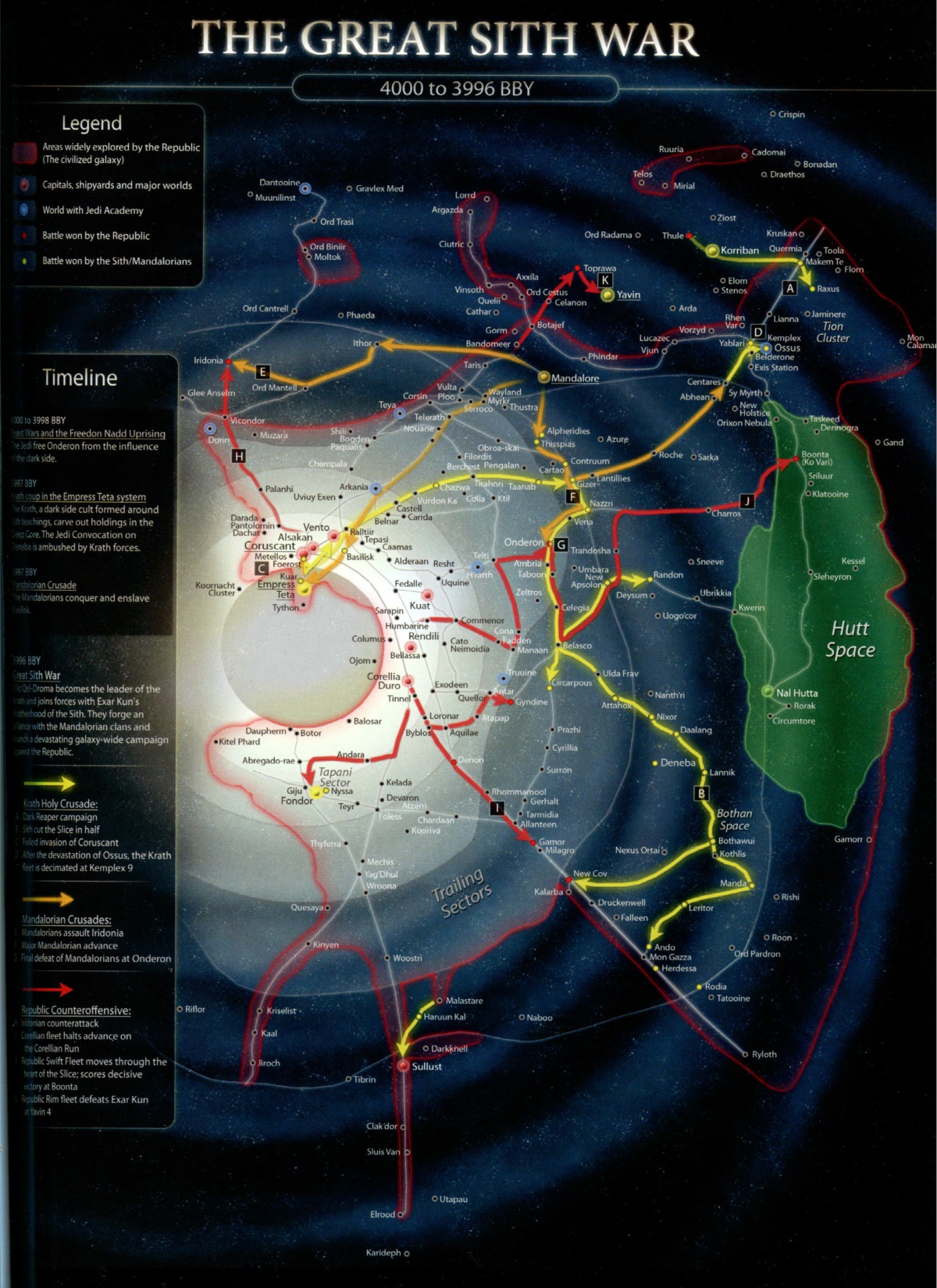
The Era after the old Sith wars saw great development in society and technology, as well as a new era of expansion and colonization in the rim.
Hyperspace and other technology begins to approach the level seen in the films, and fast hyperspace travel greatly solidifies the regions of the galaxy.
As with any golden age, the forces that lead to great achievement and advancement eventually gave way to the forces of decadence and corruption.
This natural tendancy was further encouraged and incited by the Sith, using it to weaken the Republic and rebuild their power.
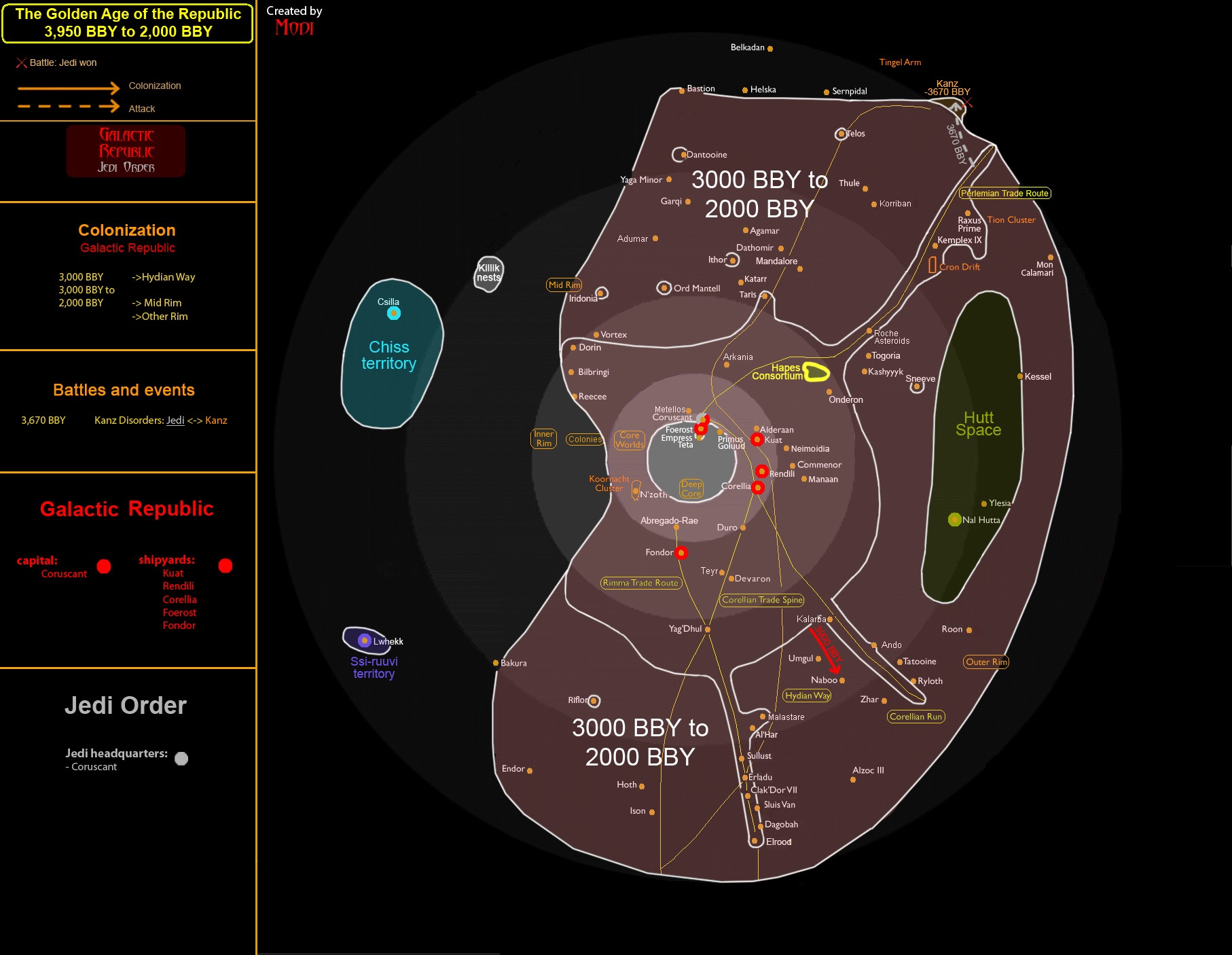
Around 2000 years before the 'modern' era of the films and shows, the Sith returned to controlling regions of known space, building their power,
and eventually growing their territory through periods of wars with the Republic. The last and most decisive of these were the New Sith Wars,
which included the fall of the Old Republic and Sith rule over large regions of the galaxy, as well as the establishment of the Galactic Republic
and the near destruction of the Sith Order. The Jedi Order and the Galactic Republic believed the Sith to be extinct.
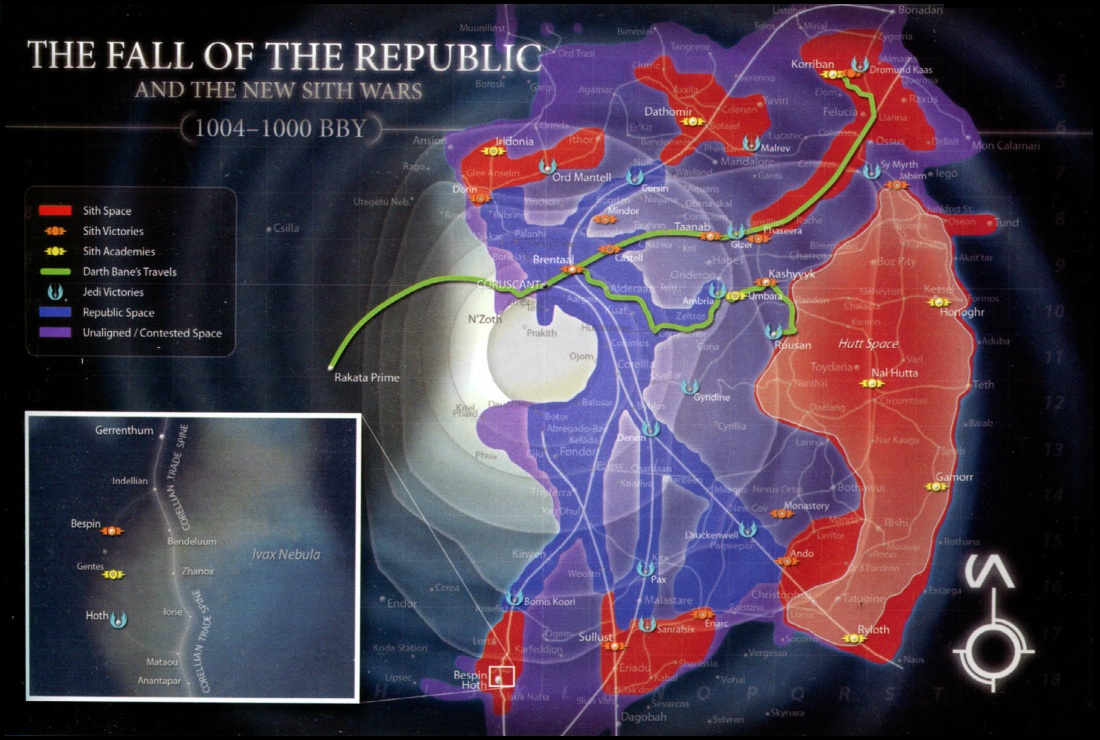
The thousand years preceding the era of the films and shows were largely an era of peace and prosperity under the Galactic Republic.
Its power and reach in the known galaxy was unchallenged, and while there were many independent systems throughout the galaxy, the security of
interstellar space and the routes connecting systems were managed and safeguarded by the Republic, or in the 'eastern' regions, the Hutt clan.
The influence of criminal organizations, pirates, and militant groups were kept mostly in check by the Jedi knights, who also served the galactic
senate as peacekeepers, diplomats, and warriors. The power of major economic combines such as the Trade Federation, Corporate Alliance, Banking Clan,
Commerce Guild, and Techno Union steadily increased throughout this era, and wielded more power and influence over the Republic than the vast majority
of planets in the Republic. The corruption of money and power in the Republic continued to grow to the point of causing a serious crisis of legitimacy.
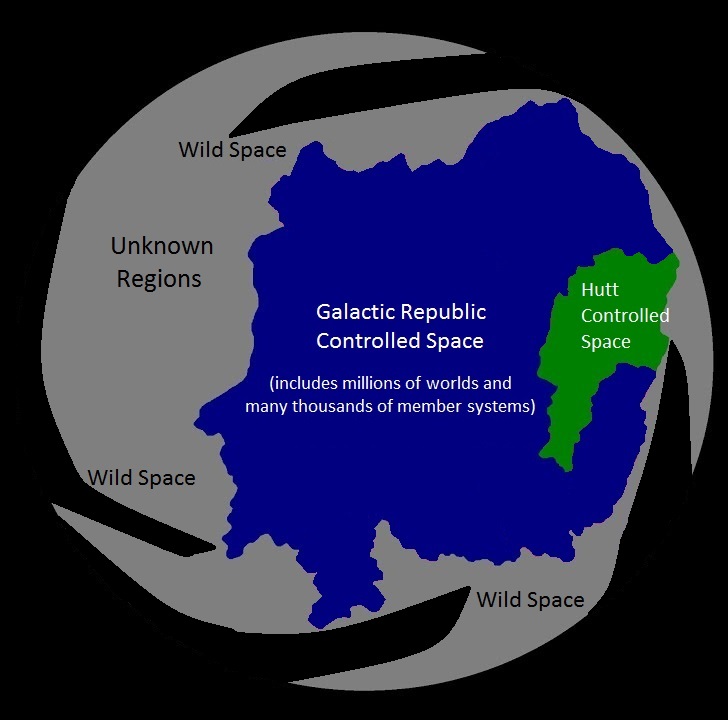
The Sith took advantage of the greed and corruption of the large economic interests, as well as the growing dissatisfaction of marginalized
member worlds, to engineer a plan to take revenge on the Jedi Order, and eliminate it as a hinderance to their efforts to control the galaxy.
Sith lords used a series of political crises, to gain control of the galactic senate, as well as the emerging separatist movement, which
threatened to leave the Republic. This led to the Clone Wars, a continuous three-year series of battles, campaigns, and planetary wars
mostly between the Galactic Republic and the Confederacy of Independent Systems, which concluded with the destruction of the Jedi Order.

After the destruction of the Jedi Order, and the Separatist leadership, the Galactic Republic, now under the control of the Sith, was
reorganized into the Galactic Empire. The Clone Wars were ended with the deactivation of the Separatist armed forces, but conflict
would continue. The Empire steadily reclaimed remaining ex-confederate regions and systems, despite widespread resistance.

Having reconquered the realms of the Republic, the Empire entered an expansion and consolidation phase, which would see the Empire conquer
or absorb the remaining independent worlds scattered throughout Imperial-controlled space, and regions previously dominated by the Hutts.
Within a dozen years of the end of the Clone Wars, the Empire essentially controlled the entire known galaxy.
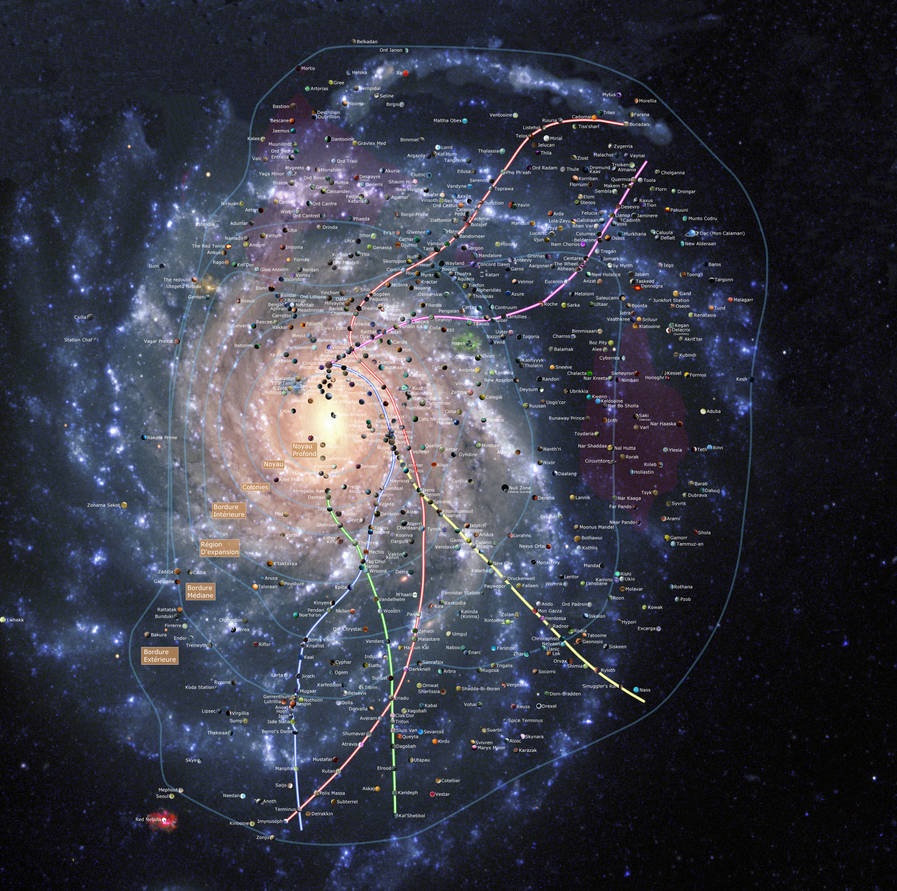
The tyranny of the Empire led to the a growing rebel movement, and eventually, the Galactic Civil War.

After the Emperor was defeated and killed during the pivotal Battle of Endor, the Empire began to rapidly crumble.
Revolt, revolution, and rebellion swept through the most populated regions of the galaxy, and a New Republic was formed.
The rapidly decaying Empire still retained a significant presence in the 'northern' galaxy.

After the Imperial surrender, Imperial remnants distant from the core were effectively left to themselves. This was obstensibly done to end
open warfare, but was in reality a practical concession, as the New Republic didn't have the strength to rule or police outlying regions, and it's
own charter strongly opposed the concept of forcing starsystems to submit to centralized government. The continued collapse of these Imperial
remnants was eventually halted, and their territories solidified. Within a few years of the end of the Civil War, the much reduced Empire
was again growing in strength. This is the era of The Mandalorian and its associated shows, what happens next remains to be seen...
...but it is worth noting that since these new shows take place in or around 9 ABY, and involve Admiral Thrawn, it may be that we
will soon see some adaptation of the story from the original Thrawn books, in which case Thrawn's campaigns are on the horizon.

INTERACTIVE MAPS
World of Star Wars Galaxy Map
The Ultimate Star Wars Galaxy Map
Atlas Galaxie Star Wars 2D [French]